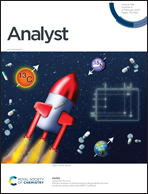Visual detection of Cronobacter sakazakii on a microfluidic chip fabricated by a 3D molding method†
Abstract
Cronobacter sakazakii (C. sakazakii) is a pathogenic bacterium associated with life-threatening neonatal infections that have been linked to contaminated powdered infant formula (PIF). Most C. sakazakii testing is still limited in microbiology laboratories due to the need for sophisticated equipment and professional technicians. Microfluidic chips combined with isothermal amplification analysis are shown to be one of the most attractive microbiological on-site detection platforms. In this study, PDMS microfluidic chips were fabricated by a simple 3D molding method and sealed with “PDMS glue”. The chip consisted of an inlet, a microchannel, six reaction wells, and six vent holes. And based on the 16S rRNA and ITS genes of C. sakazakii, we have successfully proposed a multiplex competitive annealing mediated isothermal amplification (mCAMP) assay on the microfluidic chip for the visual detection of C. sakazakii in PIF samples. The primers were fixed in the reaction wells of the chip before detection, which can be preserved for 60 days at 4 °C. The results showed that the established mCAMP assay had high specificity, and the limit of detection was 2.2 × 103 CFU g−1. With enrichment culture, even if the initial inoculation level is 1 CFU g−1, the mCAMP assay can still detect the presence of C. sakazakii in spiked PIF samples. The test results are visible to the naked eye, which is suitable for rapid analysis in resource-limited settings.



 Please wait while we load your content...
Please wait while we load your content...